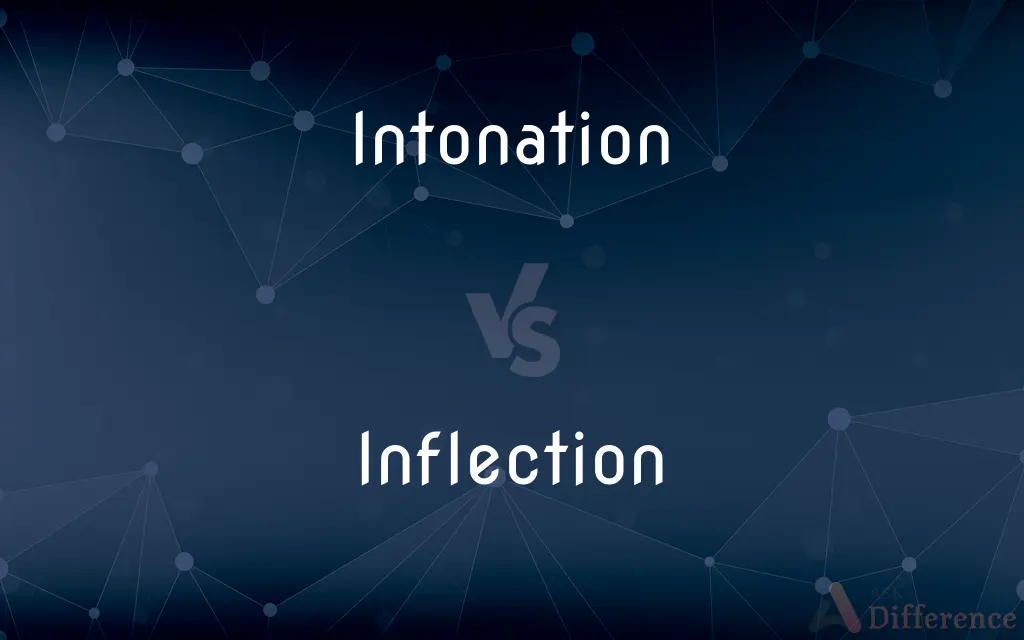Intonation vs. Inflection — What's the Difference?
By Fiza Rafique & Urooj Arif — Updated on March 8, 2024
Intonation is the variation in pitch across phrases or sentences, while inflection refers to changes in word form to express grammatical relationships.

Difference Between Intonation and Inflection
Table of Contents
ADVERTISEMENT
Key Differences
Intonation involves the rise and fall of pitch in speech, affecting the overall melody and conveying emotions, questions, or statements. It plays a crucial role in communication, influencing how a message is interpreted. On the other hand, inflection involves the modification of words, typically through prefixes, suffixes, or internal changes, to indicate aspects such as tense, case, number, or mood.
The use of intonation can change the meaning of a sentence without altering the words themselves, indicating whether something is a question, statement, or command. Inflection, however, changes the form of words to express grammatical relationships, such as between subjects and objects, or to denote time frames.
Intonation is a feature of spoken language that provides cues about the speaker's attitude or emotional state, and can even distinguish between regional accents or dialects. Whereas inflection is a linguistic feature that applies to the structure of words, affecting their grammatical function and meaning within sentences.
While intonation patterns vary widely across languages and can be subtle or pronounced, inflections are more rigidly defined within a language's grammar, with specific rules governing their use. Both are essential for conveying meaning but operate at different levels of language structure.
Understanding the difference between intonation and inflection is vital for mastering a language, as both contribute to the richness and precision of communication. Intonation adds nuance to spoken language, while inflection provides clarity and specificity to grammatical structures.
ADVERTISEMENT
Comparison Chart
Definition
Variation in pitch across phrases or sentences
Changes in word form to express grammatical relationships
Primary Function
Conveys emotions, questions, or statements
Indicates tense, case, number, mood, etc.
Level of Language
Spoken language feature
Grammatical structure within words
Communicates
Attitude, emotion, regional accents
Grammatical relationships, specific meanings
Variability
Can vary widely across languages and dialects
Governed by specific grammatical rules
Compare with Definitions
Intonation
Pitch variation.
Her intonation rose at the end of the sentence, indicating a question.
Inflection
Tense marking.
The verb talk becomes talked to indicate past tense.
Intonation
Emotional conveyance.
The intonation of his voice conveyed frustration.
Inflection
Case indication.
The change from he to him indicates object case in pronouns.
Intonation
Communicative function.
Intonation can signal whether we are making a joke or being serious.
Inflection
Gender distinction.
In some languages, nouns are inflected to denote gender.
Intonation
Accent differentiation.
Regional accents can be distinguished by intonation patterns.
Inflection
Mood expression.
The subjunctive mood is often marked by inflection in verbs.
Intonation
Statement vs. question.
Changing the intonation can turn a statement into a question.
Inflection
Plurality.
Adding s to cat makes it cats, indicating more than one.
Intonation
The act of intoning or chanting.
Inflection
In linguistic morphology, inflection (or inflexion) is a process of word formation, in which a word is modified to express different grammatical categories such as tense, case, voice, aspect, person, number, gender, mood, animacy, and definiteness. The inflection of verbs is called conjugation, and one can refer to the inflection of nouns, adjectives, adverbs, pronouns, determiners, participles, prepositions and postpositions, numerals, articles etc., as declension.
Intonation
An intoned utterance.
Inflection
The act of inflecting or the state of being inflected.
Intonation
A manner of producing or uttering tones, especially with regard to accuracy of pitch.
Inflection
Alteration in pitch or tone of the voice.
Intonation
(Linguistics) The use of changing pitch to convey syntactic information
A questioning intonation.
Inflection
An alteration of the form of a word by the addition of an affix, as in English dogs from dog, or by changing the form of a base, as in English spoke from speak, that indicates grammatical features such as number, person, mood, or tense.
Intonation
A use of pitch characteristic of a speaker or dialect
"He could hear authority, the old parish intonation coming back into his voice" (Graham Greene).
Inflection
An affix indicating such a grammatical feature, as the -s in the English third person singular verb form speaks.
Intonation
(Music) The opening phrase of a plainsong composition sung as a solo part.
Inflection
The paradigm of a word.
Intonation
(linguistics) The rise and fall of the voice in speaking.
Inflection
A pattern of forming paradigms, such as noun inflection or verb inflection.
Intonation
Emotive stress used to increase the power of delivery in speech.
Inflection
A turning or bending away from a course or position of alignment.
Intonation
A sound made by, or resembling that made by, a musical instrument.
Inflection
Change in the form of a word (morphologic change) to express different grammatical categories.
In English, word order often does the work that inflection did in Latin
Intonation
Singing or playing in good tune or otherwise.
Her intonation was false.
Inflection
An instance of such change.
An inflection for gender, number, or tense
Intonation
Reciting in a musical prolonged tone; intonating or singing of the opening phrase of a plain-chant, psalm, or canticle by a single voice, as of a priest.
Inflection
(grammar) An affix representing such an instance.
English's regular inflection for number in plural nouns is the suffix -s.
Intonation
A thundering; thunder.
Inflection
Any form produced by such an instance of a change, such as the principal parts for any given stem: any of the declined or conjugated forms that constitute its declension or conjugation.
Recite every inflection for each of these words.
Intonation
The act of sounding the tones of the musical scale.
Inflection
A change in pitch or tone of voice.
If he's lying, his inflection changes.
Intonation
The manner of speaking, especially the placement of emphasis, the cadence, and the rise and fall of the pitch of the voice while speaking.
Inflection
(mathematics) A change in curvature from concave to convex or from convex to concave.
Intonation
Rise and fall of the voice pitch
Inflection
A turning away from a straight course.
Inflection from the rules
Intonation
Singing by a soloist of the opening piece of plainsong
Inflection
(optometry) Diffraction.
Intonation
The act of singing in a monotonous tone
Inflection
The act of inflecting, or the state of being inflected.
Intonation
The production of musical tones (by voice or instrument); especially the exactitude of the pitch relations
Inflection
A bend; a fold; a curve; a turn; a twist.
Inflection
A slide, modulation, or accent of the voice; as, the rising and the falling inflection.
Inflection
The variation or change which words undergo to mark case, gender, number, comparison, tense, person, mood, voice, etc.
Inflection
Any change or modification in the pitch or tone of the voice.
Inflection
Same as Diffraction.
Inflection
A change in the form of a word (usually by adding a suffix) to indicate a change in its grammatical function
Inflection
The patterns of stress and intonation in a language
Inflection
Deviation from a straight or normal course
Inflection
A manner of speaking in which the loudness or pitch or tone of the voice is modified
Common Curiosities
Is intonation important in all languages?
Yes, intonation plays a significant role in all spoken languages, though its use and importance vary.
What is intonation in speech?
Intonation is the variation in pitch across phrases or sentences in spoken language, influencing how messages are perceived.
Can intonation change the meaning of a sentence?
Yes, intonation can change the meaning of a sentence, distinguishing between questions, statements, and commands.
How does inflection affect word meaning?
Inflection modifies words to fit grammatical contexts, altering their form to convey different meanings or relationships.
Can the same word have different inflections?
Yes, a word can have different inflections to indicate various grammatical categories like tense, number, or case.
How do intonation and inflection interact in language?
Intonation and inflection work together to convey meaning, with intonation adding emotional or attitudinal nuance and inflection providing grammatical clarity.
Does intonation only convey questions and statements?
No, intonation also conveys emotions, attitudes, and can differentiate regional accents.
How are inflections learned in a new language?
Inflections are learned through study of the language's grammatical rules and practice in various contexts.
Are there languages without inflection?
Yes, some languages, like Mandarin Chinese, use minimal inflection, relying more on word order and particles.
What is inflection in linguistics?
Inflection refers to changes in the form of words to express grammatical relationships, such as tense, number, or mood.
Does every language use inflection in the same way?
No, the use and complexity of inflection vary widely among languages.
Can intonation affect comprehension in a second language?
Yes, understanding and using intonation correctly can significantly impact comprehension and communication in a second language.
Are inflections always suffixes?
No, inflections can be suffixes, prefixes, or internal changes within a word.
Can intonation vary within the same language?
Yes, intonation can vary widely across regions, social groups, and individual speakers within the same language.
Can intonation patterns be learned?
Yes, intonation patterns can be learned through exposure, practice, and formal instruction.
Share Your Discovery

Previous Comparison
Posole vs. Pozole
Next Comparison
Schlepp vs. SchlepAuthor Spotlight
Written by
Fiza RafiqueFiza Rafique is a skilled content writer at AskDifference.com, where she meticulously refines and enhances written pieces. Drawing from her vast editorial expertise, Fiza ensures clarity, accuracy, and precision in every article. Passionate about language, she continually seeks to elevate the quality of content for readers worldwide.
Co-written by
Urooj ArifUrooj is a skilled content writer at Ask Difference, known for her exceptional ability to simplify complex topics into engaging and informative content. With a passion for research and a flair for clear, concise writing, she consistently delivers articles that resonate with our diverse audience.














































